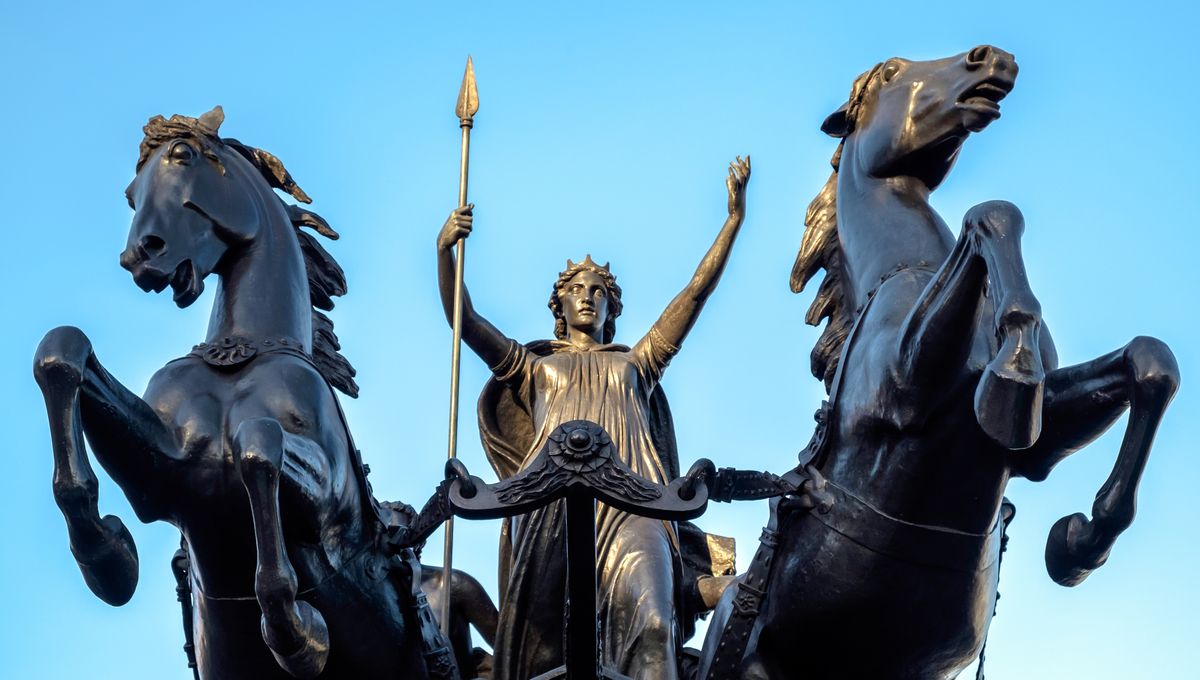
The Earthly remains and the tomb of Queen Boudicca have never been found, although many theories of her final resting place have been suggested, ranging from Stonehenge and a McDonald’s to beneath London King’s Cross train station.
Boudicca was the queen of the ancient British Iceni tribe known for leading a courageous – but ill-fated –uprising against the conquering forces of the Roman Empire in 60 CE. Often depicted with fiery red hair on top of a horse-pulled chariot, her story has become a staple of British folk history as a symbol of freedom and rebellion.
Despite her huge historical and cultural legacy, there are many unknowns surrounding her life. It’s believed she died in 60 or 61 CE. Ancient Roman historian Tacitus said that she and her daughters drank from a poisoned chalice and killed themselves, while Greek historian Cassius Dio wrote that she died from illness and was given a burial fit for a queen.
Regardless of how the death occurred, it’s also uncertain where exactly this death took place, leaving the location of the burial unknown.
One of the most recurring stories is that she was buried beneath Platform 9 or 10 of King’s Cross Station. Would that be Platform 9 and ¾? This theory is based on a book written in 1937 by Lewis Spence that argued she fought her last battle against the Romans at what is now the site of the station.
While Spence never suggested that she was buried at the site, it became a popular tale in post-war Britain. However, there’s no archeological evidence to suggest Boudicca is buried here.
Another theory is that she’s buried elsewhere in London in Hampstead Heath. Within this park, there’s a circular mound that measures some 36 meters (120 feet) in diameter and 3 meters (10 feet) in height known as “Boudicca’s Grave”.
Such burial mounds were common in many Iron Age cultures of Europe as graves for elites, leading to some suspect that an ancient leader may have been laid to rest there. However, this one almost certainly has nothing to do with Boudicca, as proved by the archaeological digs that have reportedly delved into the mounds.
Way back in 1624, historian Edmund Bolton proposed that Stonehenge had been built as the tomb of Boudicca. It’s a fantastical idea, although totally unsubstantiated. Radiocarbon dating of Stonehenge’s rocks has shown the monument is significantly older than Boudicca, likely built 5,000 years ago in a series of stages.
In 2006, archaeologists were digging next to a McDonald’s in Birmingham and came across a collection of Roman remains. This led one historian to lightly suggest it was the site of a battle fought by Boudicca, possibly where she even died, although most experts were highly skeptical.
Arguably one of the more solid arguments comes from the Birdlip graves in Gloucestershire. Accidentally discovered in 1879 by a team of workers, the haul includes some of the finest items of Celtic art ever to be found in Britain, including a handheld mirror of bronze, bronze bowls, and ornate jewelry.
Most fascinating of all, they also unearthed the skeletal remains of an individual dated to the middle part of the 1st century CE. Judging the objects buried here, this person was a woman of high status. Could this be Boudicca? It’s tempting to think so but, once again, there’s no concrete evidence.
It’s hard to know whether the remains will ever be found – and, perhaps more to the point, how anyone could prove they were definitively the bones of Boudicca. However, you can be certain that many more suggestions for her possible burial site will continue to rise and fall as the years go by.
Source Link: Boudicca's Tomb: The Remains Of The Iconic Rebel Are Still A Mystery